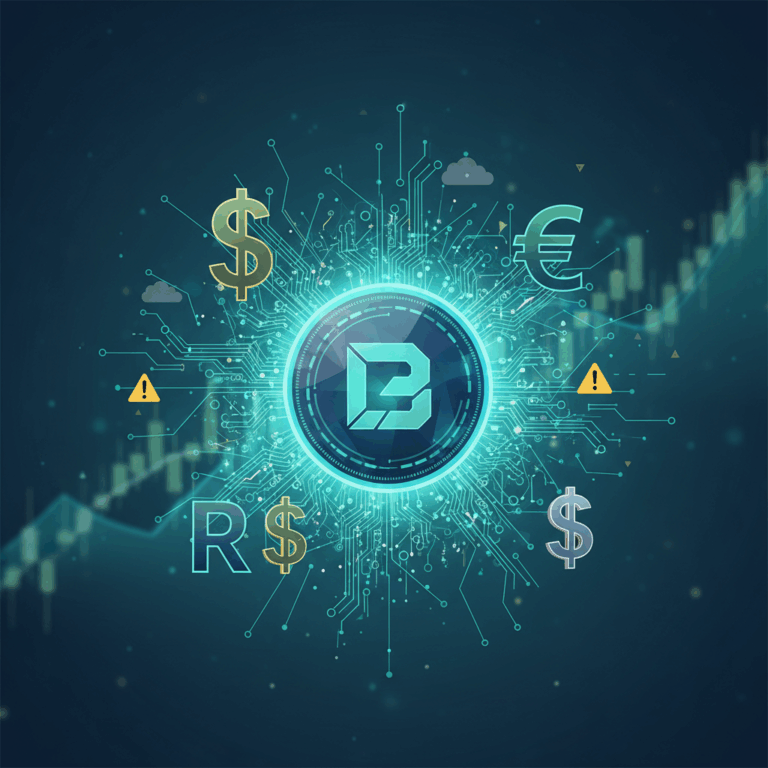Definition and function of stablecoins
The stablecoins They are cryptocurrencies created to maintain a stable value, avoiding the volatility typical of coins like Bitcoin or Ethereum.
Its main function is to serve as bridge between the crypto world and the traditional financial system, facilitating reliable and fast transactions.
These digital currencies seek to maintain their parity by being pegged to reserve assets or through algorithmic mechanisms that regulate their supply.
Basic concept and purpose
The fundamental concept of stablecoins is to offer a digital currency with stable price to avoid sudden market fluctuations.
The purpose is to provide security to users and companies that wish to operate with cryptocurrencies without the uncertainty of fluctuating value.
This makes them ideal for payments, remittances and as a tool to protect against the volatility of other cryptocurrencies.
Main mechanisms for maintaining stability
To ensure stability, stablecoins are linked to reserve assets such as fiat currencies, commodities, or cryptocurrencies.
In addition, there are algorithmic stablecoins that control their supply through algorithms that respond automatically to demand.
These mechanisms aim to ensure that each unit always represents a value close to the reference, guaranteeing reliability and consistent utility.
Stablecoin backup models
Stablecoins use different backing models to maintain their value stable and reliable for users and investors.
These models vary depending on the type of asset that backs the currency, which influences its level of security and associated risk.
Understanding these models is key to evaluating the trustworthiness and usefulness of each type of stablecoin in the current market.
Collateralization with fiat money
This model implies that each stablecoin is backed by an equivalent amount of fiat money held in bank reserves.
For example, if there are one million stablecoins in circulation, there must be one million dollars or euros stored as backup.
This type provides high security and stability because the backing is tangible and regulated by traditional financial institutions.
Cryptocurrency collateralization
In this case, the stablecoin is backed by other cryptocurrencies whose volatility can be high, so they usually require overcollateralization.
This means that the total value of cryptocurrencies in reserve is greater than the value of stablecoins issued to protect against price drops.
This model offers greater decentralization but also presents greater risk due to fluctuating backing.
Algorithmic stablecoins
Algorithmic stablecoins do not have direct reserves; instead, they use automated algorithms to adjust supply according to market demand.
When demand rises, the algorithm creates more coins, and when it falls, it reduces the quantity, seeking to maintain the established parity.
This model is innovative but can be vulnerable to unexpected market movements or failures in the automatic mechanism.
Interesting fact
Some algorithmic stablecoins have collapsed in the past due to the inability of their algorithms to respond to sudden crises, highlighting inherent risks.
Collateralization with commodities
This model uses raw materials such as gold to back the stablecoin with a tangible physical asset that is valued globally.
Commodity backing provides security and protects the currency against inflation or devaluation of fiat currencies.
It is less common, but it provides diversification and stability based on natural resources with constant demand.
Main risks associated with stablecoins
Stablecoins, although designed to offer stability, face various challenges. financial and operational risks that can affect its function and value.
Furthermore, his regulatory environment and market conditions can create uncertainty and challenges for issuers and users.
Understanding these risks is essential to assessing the safety and feasibility of using stablecoins in transactions and as a store of value.
Financial and operational risks
There is a risk that the issuer will not manage the reserves properly, generating insufficient backing to guarantee stability.
Furthermore, liquidity can be compromised if many users attempt to redeem their stablecoins simultaneously and the reserves are not liquid.
Algorithmic stablecoins face technological risks if their automated mechanisms fail in the face of sudden market movements.
Operational problems, such as errors in audits or infrastructure failures, can also affect trust and performance.
Regulatory and market risks
The absence of a clear regulatory framework can lead to abrupt regulatory changes that affect the legality and operation of some stablecoins.
Extreme market events can lead to loss of parity, especially in issues with less oversight or insufficient backing.
Regulatory initiatives seek to protect users, but global uncertainties and discrepancies increase the complexity of the environment.
Importance and transparency in stablecoins
The importance The appeal of stablecoins lies in their ability to offer a stable alternative within the crypto world, facilitating reliable transactions and payments.
Their transparency in providing support is key to building trust between users and institutions, guaranteeing the security and the stability of the value.
These characteristics allow for increasing adoption, making stablecoins an essential bridge between traditional and digital finance.
Audits and backup guarantees
Periodic audits are essential to verify that stablecoins have the necessary reserves to back up their stated value.
Transparency in reports and reviews increases credibility between users, ensuring they can exchange stablecoins with confidence.
Clear guarantees of support avoid insolvency risks and strengthen the image before regulatory entities and financial markets.
Relevance to the financial system and users
Stablecoins facilitate fast and affordable transfers, becoming increasingly integrated into international payments, remittances, and financial services.
For users, they offer stability against crypto volatility and allow them to take advantage of benefits without abandoning the security of fiat value.
Its role in the financial system is key to driving innovation, reducing costs, and promoting global financial inclusion.






